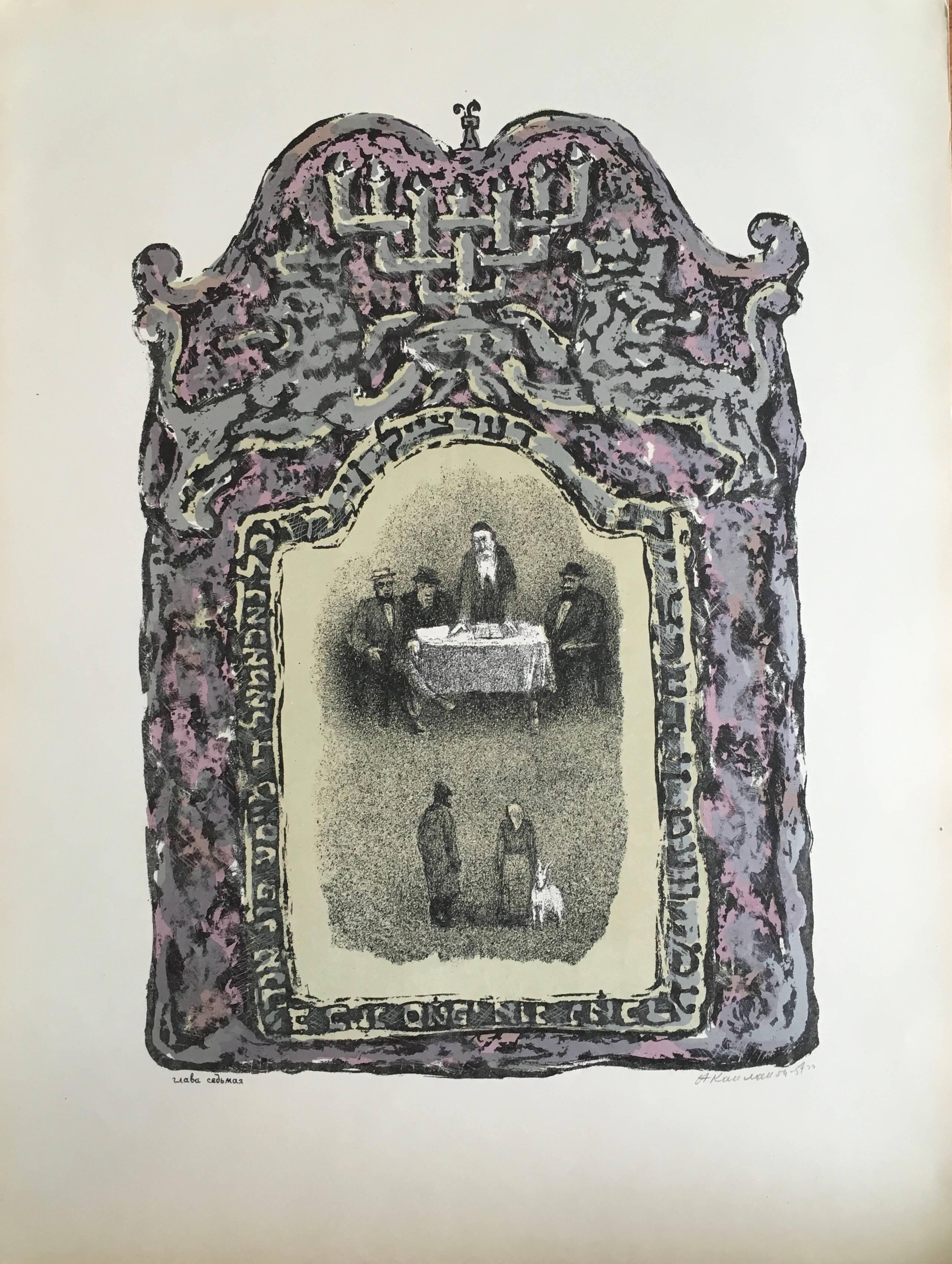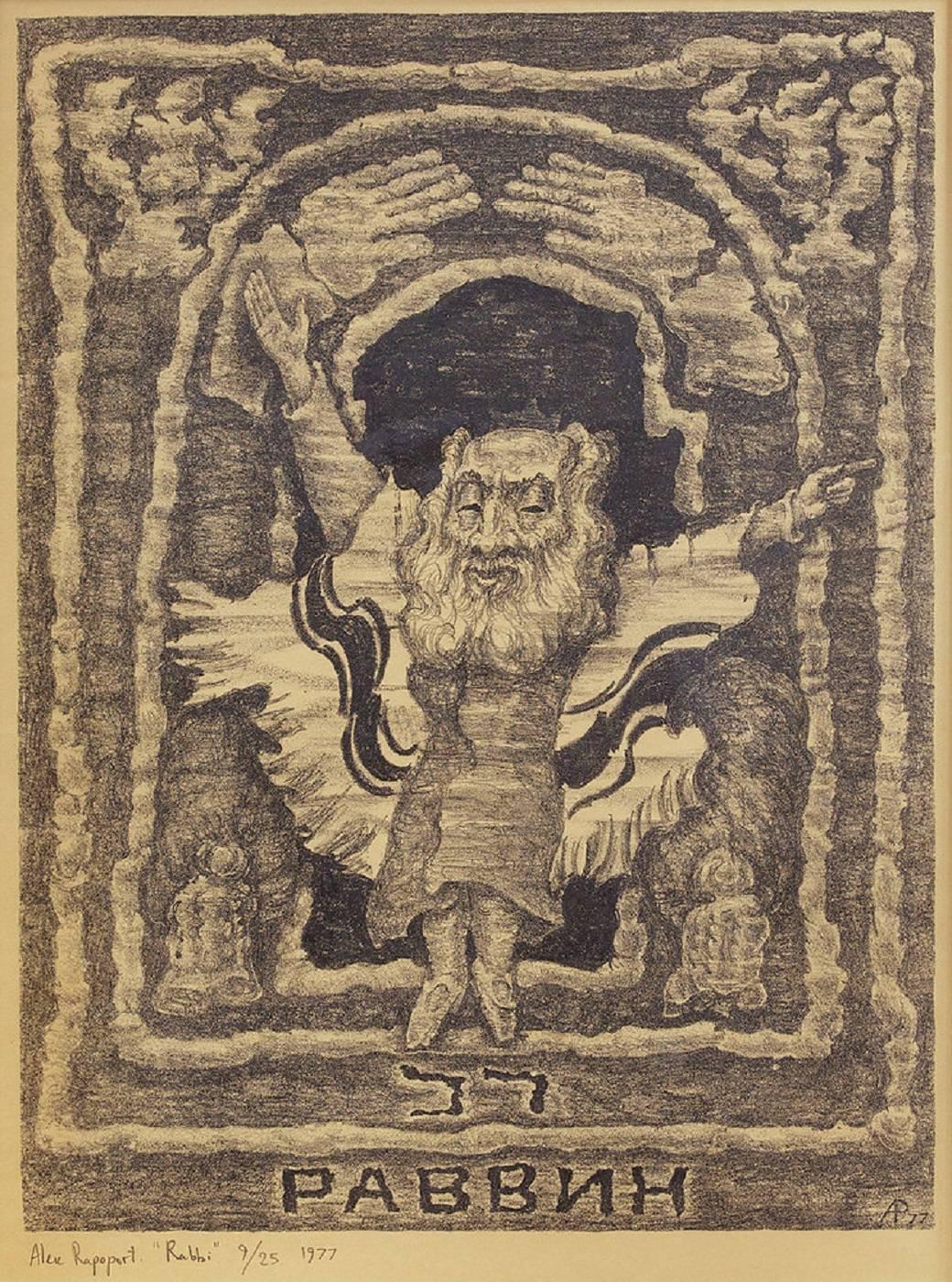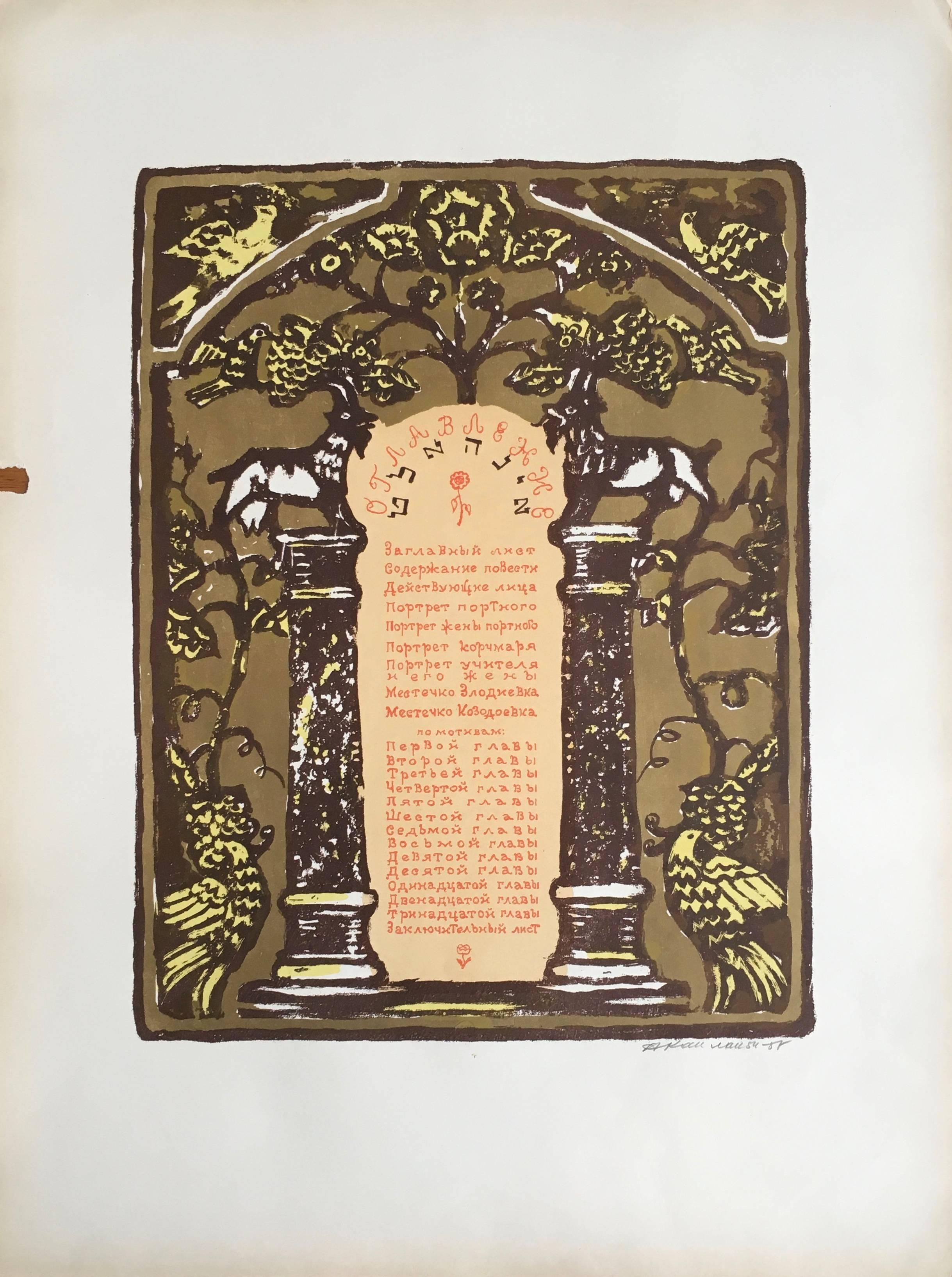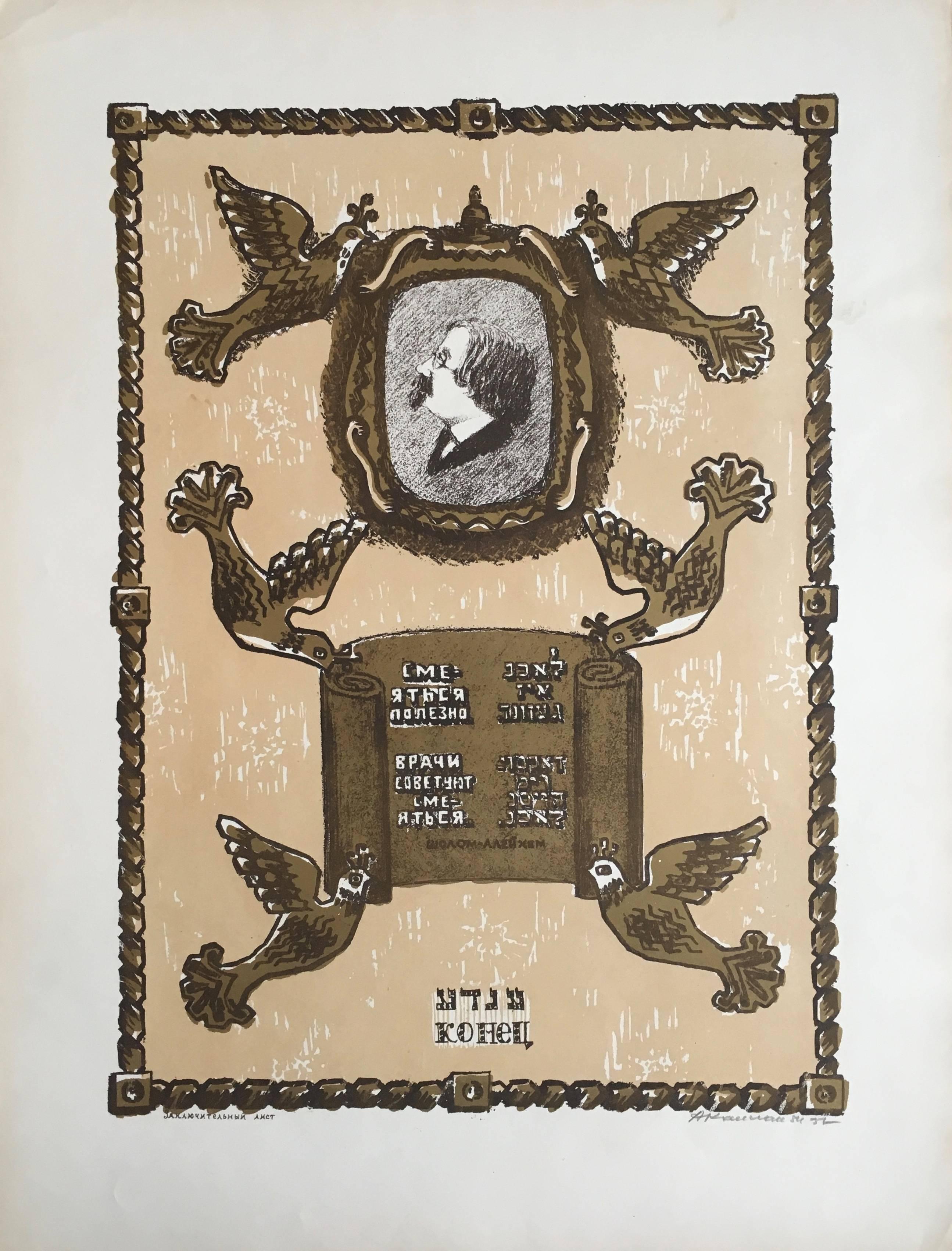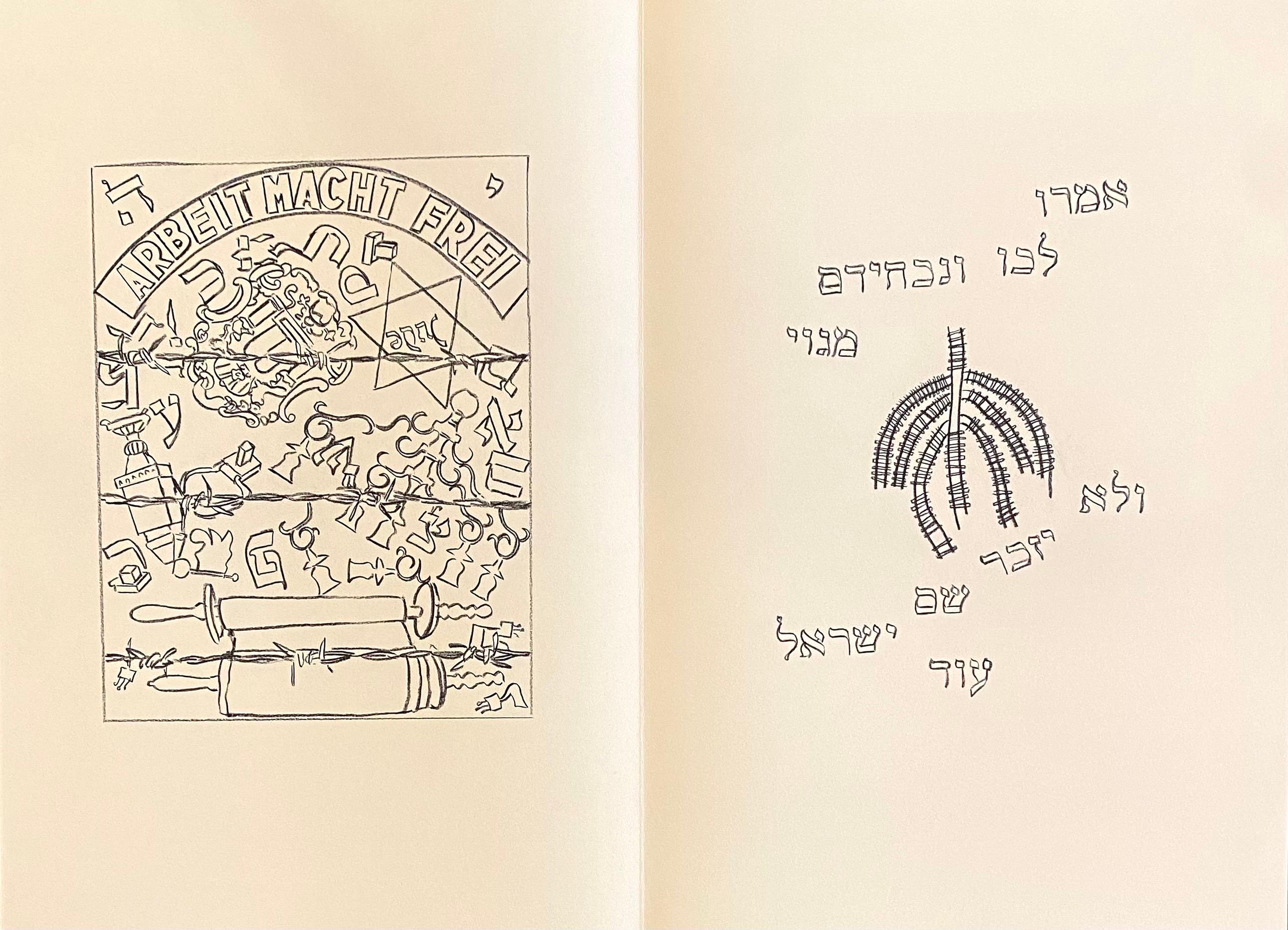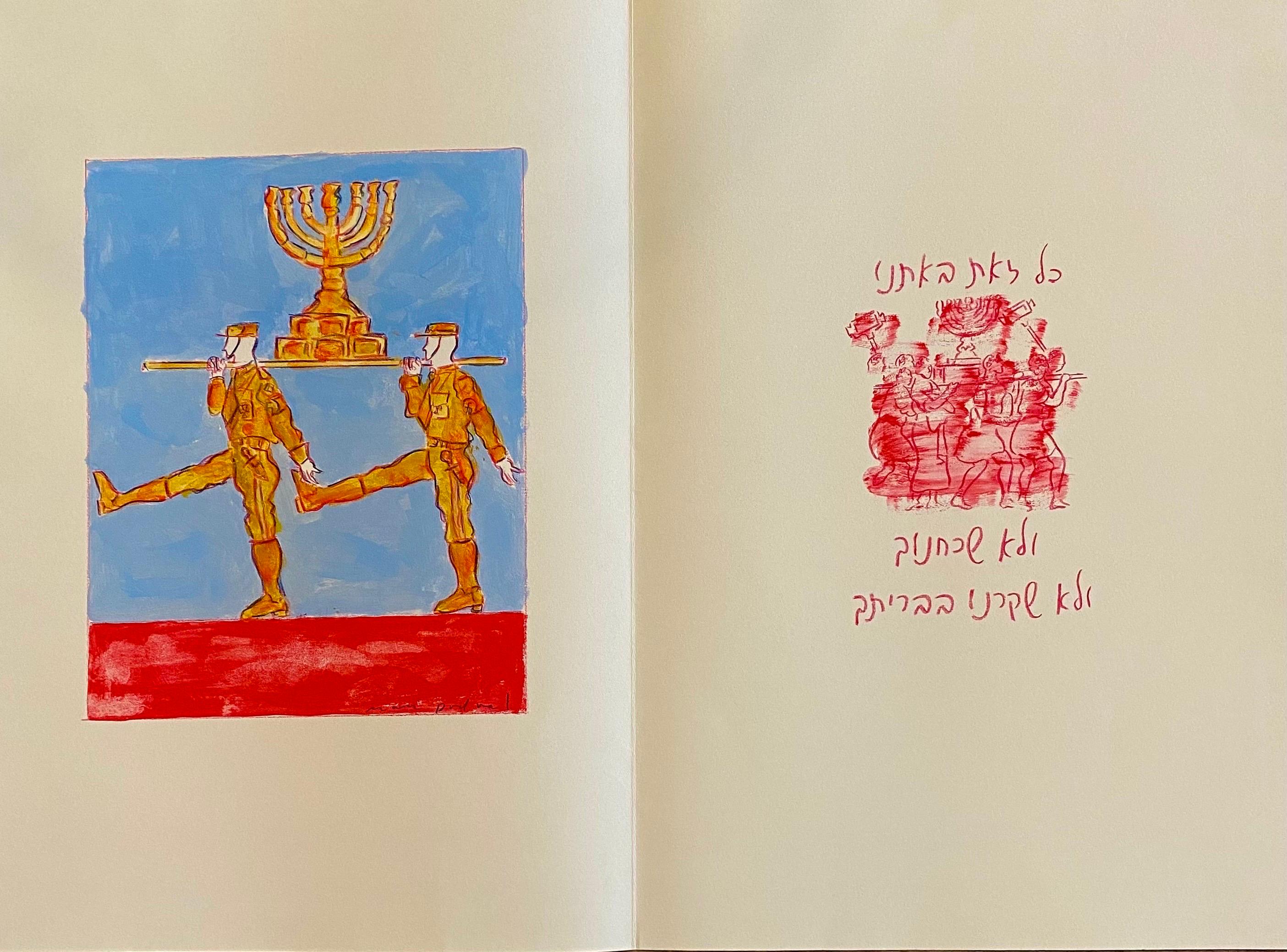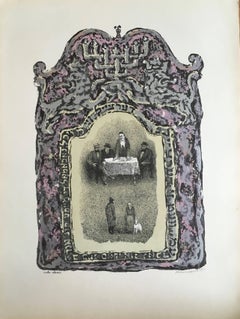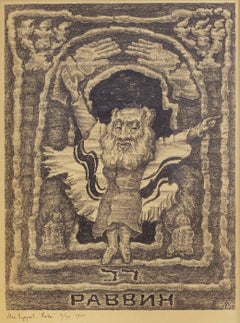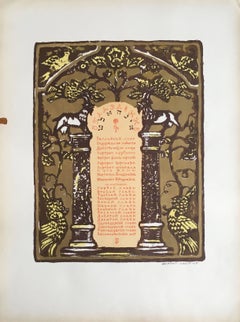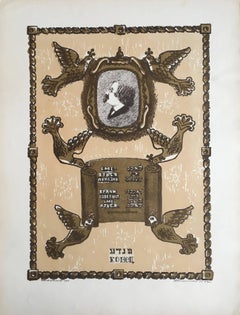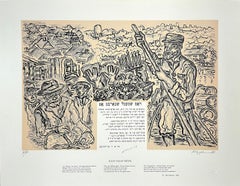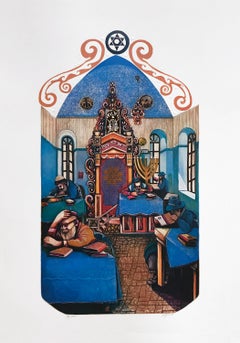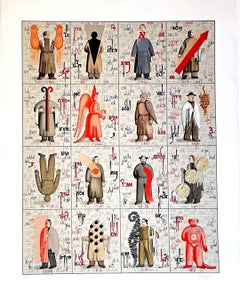Items Similar to The Talmudists Post Soviet Non Conformist Avant Garde Judaica Lithograph
Want more images or videos?
Request additional images or videos from the seller
1 of 8
Alek RapoportThe Talmudists Post Soviet Non Conformist Avant Garde Judaica Lithograph1977
1977
$875
£677.88
€772.18
CA$1,252.77
A$1,368.12
CHF 718.15
MX$16,409.40
NOK 9,044.70
SEK 8,496.46
DKK 5,766.04
About the Item
Dimensions w/Frame: 18.5 X 14.5
Alek Rapoport (November 24, 1933, Kharkiv, Ukraine SSR – February 4, 1997, San Francisco) was a Russian Nonconformist artist, art theorist and teacher.
Alek Rapoport spent his childhood in Kiev (Ukraine SSR). During Stalin's "purges" both his parents were arrested. His father was shot and his mother spent ten years in a Siberian labor camp. Rapoport lived with his aunt. At the beginning of World War II, he was evacuated to the city of Ufa (the Bashkir Autonomous Soviet Socialist Republic). A time of extreme loneliness, cold, hunger and deprivation, this period also marked the beginning of Rapoport's drawing studies.
After the war, Rapoport lived in Chernovtsy (Western Ukraine), a city with a certain European flair. At the local House of Folk Arts, he found his first art teacher, E.Sagaidachny (1886–1961), a former member of the nonconformist artist groups Union of the Youth (Soyuz Molodyozhi) and Donkey's Tail, popular during the 1910s–1920s. His other art teacher was I. Beklemisheva (1903–1988). Impressed by Rapoport's talent, she later (1950) organized his move to Leningrad, where he entered the famous V.Serov School of Art (the former School of the Imperial Society for the Promotion of Arts, OPKh, later the Tavricheskaya Art School).
His association with this school lasted eight years, first as a student, and then, from 1965 to 1968, as a teacher. With "Socialist realism" the only official style during this time, most of the art school's faculty had to conceal any prior involvement in non-conformist art movements. Ya.K.Shablovsky, V.M.Sudakov, A.A.Gromov introduced their students to Constructivism only through clandestine means.
(1959–1963) Rapoport studied stage design at the Leningrad Institute of Theater, Music and Cinema under the supervision of the famous artist and stage director N.P.Akimov. Akimov taught a unique course based on theories of Russian Suprematism and Constructivism, while encouraging his graduate students to apply their knowledge to every field of art design. Despite differences in personal artistic taste with Akimov, who was drawn to Vermeer and Dalí, Rapoport was influenced by Akimov's personality and liberalism, as well as the logical style of his art.
In 1963, Rapoport graduated from the institute. His highly acclaimed MFA work involved the stage and costume design for I.Babel's play Sunset. In preparation, he traveled to the southwest regions of the Soviet Union, where he accumulated many objects of Judaic iconography from former ghettos, disappearing synagogues and old cemeteries. He wandered Odessa in search of Babel's characters and the atmosphere of his books.
He organized a new liberal course in technical aesthetics, introducing his students to Lotman's theory of semiotics, the Modulor of Le Corbusier, the Bauhaus school, Russian Constructivism, Russian icons and contemporary Western art. As a result of his "radicalism," Rapoport was fired for "ideological conspiracy."
He sought to cultivate himself as Jewish artist. This became particularly noticeable after the Six-Day War, when the Israeli victory led intellectuals, including the Jewish intelligentsia, to feel a heightened interest in Jewish culture and its Biblical roots. Rapoport's works of this period include Three Figures, a series of images of Talmudic Scholars, and works dealing with anti-Semitism. In the 1970s Rapoport joined the non-conformist movement, which opposed the dogmas of "Socialist realism" in art, along with Soviet censorship. The movement sought to preserve the traditions of Russian iconography and the Constructivist/Suprematist style of the 1910s. Despite the authorities' persecutions of nonconformist artists (including arrests, forced evictions, terminations of employment, and various forms of routine hassling), they united in a group, "TEV – Fellowship of Experimental Exhibitions." TEV's exhibitions proved tremendously successful.
In the same period, Rapoport became one of the initiators of another anti-establishment group, ALEF (Union of Leningrad's Jewish Artists). In the United States this group was known as "Twelve from the Soviet Underground." Rapoport's involvement with this group increased tension with the authorities and attracted KGB scrutiny, including "friendly conversations," surveillance, detentions and house arrests. It became increasingly dangerous for him to live and work in the USSR. In October 1976, Rapoport with his wife and son were forced to leave Russia.
In Italy, Rapoport exhibited at the Venice Biennale, "La Nuova Arte Sovietica-Una prospettiva non-ufficiale" (1977), participated in television programs about nonconformist art in the Soviet Union, and created lithographic works continuing his theme of Jewish characters from Babel's play Sunset.
In 1977, Rapoport's family was granted U.S. immigration status and settled in San Francisco. a significant event in Rapoport's life occurred in his meeting with San Francisco gallery owner Michael Dunev, who became his friend and representative, organizing all his exhibitions until the artist's death.
Toward the end of the 1980s and beginning of the 1990s, Rapoport completed his most ambitious works on the theme of the Old Testament prophets: Samson Destroying the House of the Philistines (1989), Lamentation and Mourning and Woe (1990), the four paintings Angel and Prophets (1990–1991) and Three Deeds of Moses (1992).
In 1992, the artist's friends in St. Petersburg organized the first exhibition of his works there since his departure into exile, with works patiently gathered from collectors and art museums. This exhibition, held in the City Museum of St. Petersburg and accompanied by headlines such as "A St. Petersburg artist returns to his town," was followed by much larger ones in 1993 (St. Petersburg and Moscow), organized in collaboration with Michael Dunev Gallery under the name California Branches – Russian Roots.
He Exhibited in "Soviet Artists, Jewish Themes," an exhibit of Nonconformist art of over 40 Jewish artists from the Soviet Union.
The variety of Jewish themes range from rural, village scenes to images of the Holocaust, to mystical interpretations based on Kabbalistic texts by artists such as Grisha Bruskin, Anatolii Kaplan, Vitaly Komar, Alexander Melamid, Leonid Lamm, Dmitrii Lion, and Alek Rapoport.
The exhibit focused on the work of Jewish artist in times of social oppression and were created in private, and were mostly kept hidden from the public eye.
Main personal exhibitions
1980 – Gallerie "Trifalco," Rome, Italy
1981 – Images of San Francisco, Eduard Nakhamkin Gallery, New York, NY.
1984 – Images of San Francisco, University of the Pacific Gallery, Stockton, CA.
1986 – Images of San Francisco, Michael Dunev Gallery, San Francisco, CA.
1988 – Ecumenical Works, Michael Dunev Gallery, San Francisco, CA.
1992 – Russia-USA, The Museum of the City of St. Petersburg, St. Petersburg, Russia.
1993 – California Branches-Russian Roots, Manege Exhibition Hall, St. Petersburg, Russia; National Exhibition Hall, Moscow, Russia.
1996 – Ecumenical Paintings, SOMAR Gallery, San Francisco, CA.
1997 – The Last Paintings: A Memorial Exhibition, Michael Dunev Gallery, San Francisco, CA; The Early Drawings. A Memorial Exhibition. George Krevsky Fine Art, San Francisco, CA; Sacred Inspiration: Icons by Alek Rapoport, The Marian Library, IMRI, Dayton University, Dayton, OH.[14]
1998 – Angel and Prophet, Center for Art and Religion, Washington, DC.
2004 – Images of San Francisco, Diaghilev Art Center, St. Petersburg, Russia.
2007 – Alek Rapoport: A Memorial Exhibition, Belcher Studios Gallery, San Francisco, CA.
- Creator:Alek Rapoport (1933, Russian)
- Creation Year:1977
- Dimensions:Height: 18.5 in (46.99 cm)Width: 14.5 in (36.83 cm)
- Medium:
- Movement & Style:
- Period:
- Condition:paper has light toning. minor crack to far corner of glass.
- Gallery Location:Surfside, FL
- Reference Number:1stDibs: LU38213001682
About the Seller
4.9
Platinum Seller
Premium sellers with a 4.7+ rating and 24-hour response times
Established in 1995
1stDibs seller since 2014
1,830 sales on 1stDibs
Typical response time: 1 hour
- ShippingRetrieving quote...Shipping from: Surfside, FL
- Return Policy
Authenticity Guarantee
In the unlikely event there’s an issue with an item’s authenticity, contact us within 1 year for a full refund. DetailsMoney-Back Guarantee
If your item is not as described, is damaged in transit, or does not arrive, contact us within 7 days for a full refund. Details24-Hour Cancellation
You have a 24-hour grace period in which to reconsider your purchase, with no questions asked.Vetted Professional Sellers
Our world-class sellers must adhere to strict standards for service and quality, maintaining the integrity of our listings.Price-Match Guarantee
If you find that a seller listed the same item for a lower price elsewhere, we’ll match it.Trusted Global Delivery
Our best-in-class carrier network provides specialized shipping options worldwide, including custom delivery.More From This Seller
View AllVIntage Russian Shtetl Scene, Judaica Lithograph
By Anatoli Lvovich Kaplan
Located in Surfside, FL
Pencil signed and dated, colored Judaica Lithograph.
Anatoli Lwowitch Kaplan was a Russian painter, sculptor and printmaker, whose works often reflect his Jewish origins.
His father...
Category
Mid-20th Century Modern More Prints
Materials
Lithograph
The Rabbi 1977 Soviet Non Conformist Avant Garde Print
By Alek Rapoport
Located in Surfside, FL
Dimensions w/Frame: 25 3/4" x 20 3/4"
Alek Rapoport (November 24, 1933, Kharkiv, Ukraine SSR – February 4, 1997, San Francisco) was a Russian Nonconformist artist, art theorist and teacher.
Alek Rapoport spent his childhood in Kiev (Ukraine SSR). During Stalin's "purges" both his parents were arrested. His father was shot and his mother spent ten years in a Siberian labor camp. Rapoport lived with his aunt. At the beginning of World War II, he was evacuated to the city of Ufa (the Bashkir Autonomous Soviet Socialist Republic). A time of extreme loneliness, cold, hunger and deprivation, this period also marked the beginning of Rapoport's drawing studies.
After the war, Rapoport lived in Chernovtsy (Western Ukraine), a city with a certain European flair. At the local House of Folk Arts, he found his first art teacher, E.Sagaidachny (1886–1961), a former member of the nonconformist artist groups Union of the Youth (Soyuz Molodyozhi) and Donkey's Tail, popular during the 1910s–1920s. His other art teacher was I. Beklemisheva (1903–1988). Impressed by Rapoport's talent, she later (1950) organized his move to Leningrad, where he entered the famous V.Serov School of Art (the former School of the Imperial Society for the Promotion of Arts, OPKh, later the Tavricheskaya Art School).
His association with this school lasted eight years, first as a student, and then, from 1965 to 1968, as a teacher. With "Socialist realism" the only official style during this time, most of the art school's faculty had to conceal any prior involvement in non-conformist art movements. Ya.K.Shablovsky, V.M.Sudakov, A.A.Gromov introduced their students to Constructivism only through clandestine means.
(1959–1963) Rapoport studied stage design at the Leningrad Institute of Theater, Music and Cinema under the supervision of the famous artist and stage director N.P.Akimov. Akimov taught a unique course based on theories of Russian Suprematism and Constructivism, while encouraging his graduate students to apply their knowledge to every field of art design. Despite differences in personal artistic taste with Akimov, who was drawn to Vermeer and Dalí, Rapoport was influenced by Akimov's personality and liberalism, as well as the logical style of his art.
In 1963, Rapoport graduated from the institute. His highly acclaimed MFA work involved the stage and costume design for I.Babel's play Sunset. In preparation, he traveled to the southwest regions of the Soviet Union, where he accumulated many objects of Judaic iconography from former ghettos, disappearing synagogues and old cemeteries. He wandered Odessa in search of Babel's characters and the atmosphere of his books.
He organized a new liberal course in technical aesthetics, introducing his students to Lotman's theory of semiotics, the Modulor of Le Corbusier, the Bauhaus school, Russian Constructivism, Russian icons and contemporary Western art. As a result of his "radicalism," Rapoport was fired for "ideological conspiracy."
He sought to cultivate himself as Jewish artist. This became particularly noticeable after the Six-Day War, when the Israeli victory led intellectuals, including the Jewish intelligentsia, to feel a heightened interest in Jewish culture and its Biblical roots. Rapoport's works of this period include Three Figures, a series of images of Talmudic Scholars, and works dealing with anti-Semitism. In the 1970s Rapoport joined the non-conformist movement, which opposed the dogmas of "Socialist realism" in art, along with Soviet censorship. The movement sought to preserve the traditions of Russian iconography and the Constructivist/Suprematist style of the 1910s. Despite the authorities' persecutions of nonconformist artists (including arrests, forced evictions, terminations of employment, and various forms of routine hassling), they united in a group, "TEV – Fellowship of Experimental Exhibitions." TEV's exhibitions proved tremendously successful.
In the same period, Rapoport became one of the initiators of another anti-establishment group, ALEF (Union of Leningrad's Jewish Artists). In the United States this group was known as "Twelve from the Soviet Underground." Rapoport's involvement with this group increased tension with the authorities and attracted KGB scrutiny, including "friendly conversations," surveillance, detentions and house arrests. It became increasingly dangerous for him to live and work in the USSR. In October 1976, Rapoport with his wife and son were forced to leave Russia.
In Italy, Rapoport exhibited at the Venice Biennale, "La Nuova Arte Sovietica-Una prospettiva non-ufficiale" (1977), participated in television programs about nonconformist art in the Soviet Union, and created lithographic works continuing his theme of Jewish characters from Babel's play Sunset.
In 1977, Rapoport's family was granted U.S. immigration status and settled in San Francisco. a significant event in Rapoport's life occurred in his meeting with San Francisco gallery owner Michael Dunev, who became his friend and representative, organizing all his exhibitions until the artist's death.
Toward the end of the 1980s and beginning of the 1990s, Rapoport completed his most ambitious works on the theme of the Old Testament prophets: Samson Destroying the House of the Philistines (1989), Lamentation and Mourning and Woe (1990), the four paintings Angel and Prophets (1990–1991) and Three Deeds of Moses (1992).
In 1992, the artist's friends in St. Petersburg organized the first exhibition of his works there since his departure into exile, with works patiently gathered from collectors and art museums. This exhibition, held in the City Museum of St. Petersburg and accompanied by headlines such as "A St. Petersburg artist returns to his town," was followed by much larger ones in 1993 (St. Petersburg and Moscow), organized in collaboration with Michael Dunev Gallery under the name California Branches – Russian Roots.
He Exhibited in "Soviet Artists, Jewish Themes...
Category
1970s Post-Modern Figurative Prints
Materials
Lithograph
Vintage Russian Shtetl Lithograph
By Anatoli Lvovich Kaplan
Located in Surfside, FL
Pencil signed and dated, colored Judaica Lithograph.
Anatoli Lwowitch Kaplan was a Russian painter, sculptor and printmaker, whose works often reflect his Jewish origins.
His fathe...
Category
Mid-20th Century Modern More Prints
Materials
Lithograph
Vintage Russian Shtetl, Scene Judaica Lithograph
By Anatoli Lvovich Kaplan
Located in Surfside, FL
Pencil signed and dated, colored Judaica Lithograph.
Anatoli Lwowitch Kaplan was a Russian painter, sculptor and printmaker, whose works often reflect his Jewish origins.
His father...
Category
Mid-20th Century Modern More Prints
Materials
Lithograph
Large Archival Pigment Print Judaica Lithograph Mark Podwal Jewish Hebrew Art
By Mark Podwal
Located in Surfside, FL
Mark Podwal (American, New York, born 1945)
"All This Has Come Upon Us"
Archival pigment print
Dimensions: 22 X 30 inches
Arbeit Macht Frei, Auschwitz Holocaust imagery with Torah
...
Category
21st Century and Contemporary Neo-Expressionist Figurative Prints
Materials
Lithograph, Archival Pigment
Large Archival Pigment Print Judaica Lithograph Mark Podwal Jewish Hebrew Art
By Mark Podwal
Located in Surfside, FL
Mark Podwal (American, New York, born 1945)
"All This Has Come Upon Us"
Archival pigment print
Dimensions: 22 X 30 inches
Soldiers carrying temple Menorah
From a 2014 portfolio of...
Category
21st Century and Contemporary Neo-Expressionist Figurative Prints
Materials
Lithograph, Archival Pigment
You May Also Like
ELEGY FOR MY SHTETL Signed Lithograph with 1938 Yiddish Poem, Jewish History
By Marius Sznajderman
Located in Union City, NJ
ELEGY FOR MY SHTETL is an original hand drawn, limited edition lithograph by Marius Sznajderman (Born - Paris, France 1926-2018) printed using hand lithography techniques on archival...
Category
1980s Contemporary Figurative Prints
Materials
Lithograph
YASHIVA IN JERUSALEM (JUDAICA ART)
By Amram Ebgi
Located in Aventura, FL
Embossed lithograph with foil stamping on paper. Hand signed and numbered by the artist. From the edition of 300.
Artwork is in excellent condition. Certificate of authenticity in...
Category
Late 20th Century Contemporary Figurative Prints
Materials
Foil
$100 Sale Price
50% Off
Eclesiastes I, 1964 Signed Etching by Sigmund Laufer
Located in Long Island City, NY
Eclesiastes I by Sigmund Laufer, German/American (1920–2007)
Date: 1964
Etching, signed and numbered in pencil
Edition of 50
Size: 22 x 15 in. (55.88 x 38.1 cm)
Category
1960s Modern Figurative Prints
Materials
Etching
Note D, silkscreen by renowned Russian-American Jewish dissident artist Signed/N
By Grisha Bruskin
Located in New York, NY
Grisha Bruskin
Note D, 1991
Color silkscreen on Somerset paper
34 × 27 inches
Edition 74/75
Boldly signed and numbered on front in graphite pencil.
Published by Marlborough Graphics ...
Category
1980s Modern Abstract Prints
Materials
Screen
Old Jew, Surrealist Lithograph by Peter Paone
Located in Long Island City, NY
Peter Paone, American (1936 - ) - Old Jew, Year: circa 1963, Medium: Lithograph on Rives, signed, titled and numbered in pencil, Edition: 11/50, Image Si...
Category
1960s Surrealist Portrait Prints
Materials
Lithograph
Untitled - Lithograph by Tono Zancanaro - 1966
By Tono Zancanaro
Located in Roma, IT
Untitled is a modern artwork realized by Tono Zancanaro in 1966.
Black and white lithograph.
Hand signed and dated on the lower margin.
Artist's proof (as reported on the lower ma...
Category
1960s Contemporary Figurative Prints
Materials
Lithograph
More Ways To Browse
Le Modulor
Royal Albert Old Country Roses
Salvador Dali 1967
Salvador Dali Mythology
Sem Georges Goursat
Sonia Delaunay Pochoirs
Toyokuni Ii
Vermeer Lithograph
Vintage 1945 Dresses
Vintage Broadway Posters
Vintage Gun Print
William Auerbach Levy
William Lionel Wyllie
Woodcut Print Jacques
15th Century Woodcut
1978 Dali
20th Century French Woodcuts
Aldemir Martins
